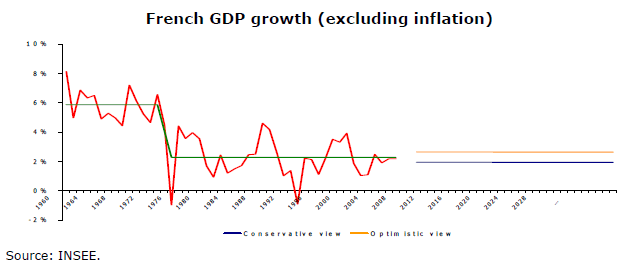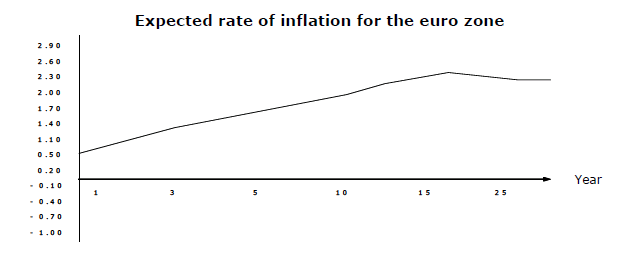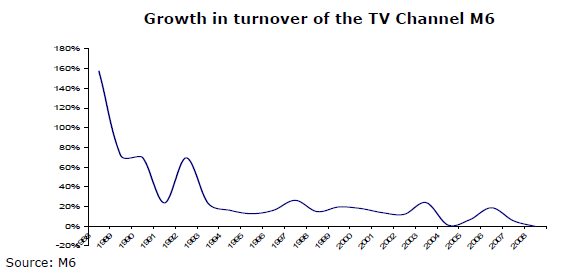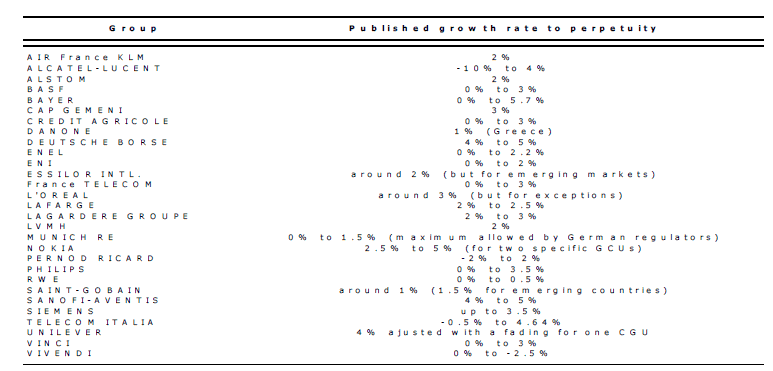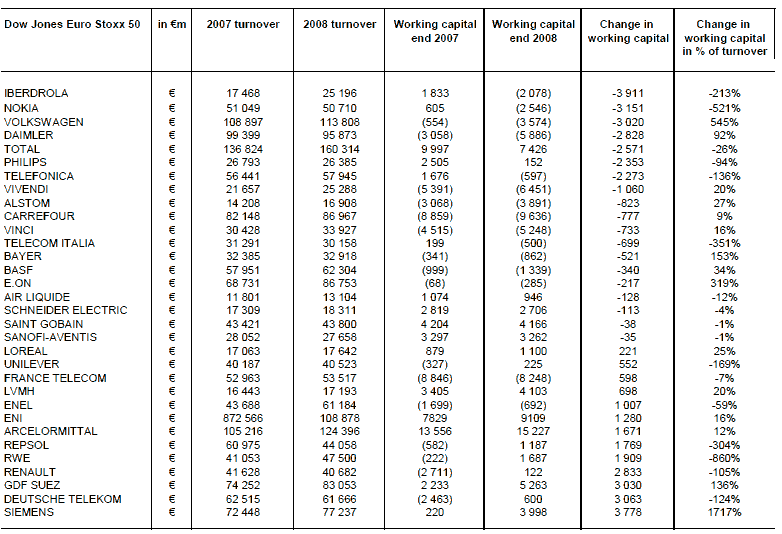Letter number 42 of July - August 2009
ALL ARTICLES
- TOPIC
- STATISTICS
- RESEARCH
- QUESTIONS & COMMENTS
News : NEWS: Growth rate to perpetuity
The discounted cash flows (DCF) method is (rightly) recognised as the most reliable method for valuing companies (1). Given its status as the preferred method of most valuation specialists, we thought it would be a good idea to take a look at the technical parameters they use when applying it.
A few months ago, we studied the risk premium paid by investors (1). This month, we’ll be looking at the calculation of terminal value, and specifically the growth rate to infinity of the last cash flow.
The basis formula for calculating terminal value is based on discounting to perpetuity the last normalised cash flow at a constant growth rate. The formula is thus cash flow / (discount rate – growth rate). This means that terminal value is highly dependent on the growth rate to infinity. Let’s take an example of a flow of 100 and a discount rate of 10%. Depending on whether we use a growth rate of 2% or 3%, the terminal value will be between 1 250 and 1 428, or a difference in value of 14%.
However, we should not forget that the discount rate is responsible for a great deal more uncertainty about the outcome of the valuation than the growth rate to infinity. If you take a look at the Vernimmen.com Newsletter n° 38, you'll see that depending on the sources, there is a 2.5% dispersion on the risk premium with an impact on value that is almost twice as high!
The growth rate to infinity should be compared with the long-term outlook for economic growth. We’ve intentionally avoided the debate on short-term growth (2009-2010) which is of little interest for our purposes here. For example, a historical analysis of French GDP growth in volume (i.e., excluding inflation) shows that since 1974, growth has oscillated at an average of around 2.3%. This rate of growth is consistent with very long-term growth forecasts (to 2050), published by INSEE in late 2006.
By comparing the returns on classic government bonds with those on government bonds indexed to inflation, we can deduce the anticipated medium-term rate of inflation. The expected medium-term rate of inflation, based on this analysis, is around 2%.
Based on a combination of the French GDP rate and expected inflation in the euro zone, we can estimate the nominal annual growth of the French economy over the long term at around 4.3%.
But why then do we use a growth rate of at best 3% for fast-growing industries and 1% for mature industries when valuing a company? Is this a mistake?
We don’t think so.
The most obvious explanation for this is the changing economy. Most of the industries and companies making up the economic landscape today did not exist 100 years ago (telecoms, Internet, airlines, mass market cosmetic, etc.). We can thus assume that the companies we are seeking to value today will only account for a minor part of the economy in 100 years!
Although some groups have succeeded in reinventing themselves by shifting from a mature sector to a high-growth sector (for example the transformation of Nokia from tyres to mobile phones) or by seeking new growth opportunities on emerging markets, growth is mainly driven by innovation and accordingly, new companies will always grab the lion's share of growth.
Let’s take the example of the TV sector. Until 1968, and the emergence of television advertising, the TV sector made no contribution to GDP whatsoever. Today, sales by French television channels are worth €5bn, or around 0.3% of GDP. It is, however, clear that the sector is starting to run out of steam and that this is now a mature market, i.e., it is growing at a slower pace than the economy as a whole. Additionally, in mature sectors, the sector-specific rate of inflation is very likely to be below the general rate of inflation, as customers are not prepared to pay higher prices for products that are not in some way innovative.
These observations confirm that, when carrying out a business valuation, the practice of using growth rates to infinity that are substantially lower than the expected growth rate of the economy, is well founded.
Nevertheless, this doesn’t provide us with a simple mathematical formula for calculating the rate to be used!
Let’s move now from theory to practice by looking at the growth rates to perpetuity used by groups when drawing up their financial statements (for the purposes of impairment tests). A large number of groups do not disclose any information on the assumptions they relied on but we have nevertheless, collated information that we were able to glean from 2007 annual reports of a few large European groups (2). Most of them assume growth of between 0% and 3%.
Finally we’d like to end on a lighter note, and warn the reader against manipulating growth figures when carrying out valuations.
We see here that growth of 20% for 10 years followed by growth of 2% beyond this period to infinity works out at average growth of only 2.65% to infinity as of today if you consider what will be the result in 250 years (with a different profile over the period).
We once had a rather delicate discussion with a valuation expert who, in order to compensate for a business plan that had been drawn up over a shorter period than ours (5 years instead of 10 years), assumed a growth rate to infinity of 2.5% compared with the 2% we had used. We were forced to point out to him that the difference between the two rates worked out at an annual growth rate of flows of more than 30% for the 5 years of the business plan that he had not taken into account.
This shows just how complicated it is to try and make up for lower short/medium term growth with a growth to infinity rate that is just a little bit higher. Infinity is a very long way off!
(1) For more details, see chapter 32 of the Vernimmen.
(2) For more details, see Vernimmen.com Newsletter N° 38, January 2009.
(3) Some groups do provide their assumptions for certain divisions (CGU).
Statistics : Changes in working capital
• 15 of the 37 non financial / real estate members of the Euro Stoxx 50 had a negative working capital end of 2008. Negative working capital is one of the attributes of powerfull group. So no one is surprised to notice that 40% of the largest Euro groups have the pleasure of having a negative working capital. As we have already written (1) the level of working capital is the testimony of the relative strength of a group versus its customers and its suppliers. Food retail is not the only sector to have a negative working capital!
• Some groups suffered form a brutal and strong deterioration in their working capital at the end of 2008 resulting into a large cash drain prompting some of them to ask for state help (Renault) or making a cash call to their shareholders (Arcelor Mittal).
• Globally changes in working capital totalled € - 3.2 bn, i.e. 0.2 % of total turnover which means that some groups have taken advantage of the crisis to dramatically improve their working capital (Total, Nokia, Telefonica, etc.).
(1) See chapter 11 of the Vernimmen.
Research : Venture capital investment practices in Europe and the USA
Innovative start-up companies often rely on venture capital (1) to finance their growth. A researcher at the Catholic University of Leuven carried out a detailed statistical analysis (2) of venture capital investment practices on both sides of the Atlantic (3). He based his work on responses to questionnaires sent out to around 600 investment funds, looking closely at the clauses of the venture capital contracts they signed with their clients.
The main results of this research is summarised below.
Before going on to highlight the differences between European and US venture capital agreements, the study shows that they do share certain similarities.
Stage financing, which involves providing the entrepreneur with the financial resources required at each stage of development, is equally widespread in Europe and the USA (the average number of stages is 2.4). This system of financing allows the fund cut its losses and exit if results are not in line with expectations (we refer to a real option, analogous with the principle of a financial option).
On the other hand, the use of convertible bonds (rather than shares), is three times more frequent in the USA than in Europe. Convertible bonds provide better protection for the fund if the investment fails and it would be better to be left holding convertible bonds than shares if results are disappointing. Having said that, if the start-up fails, its assets will not be worth much at all, and it will make little difference whether the shareholder is left holding shares or convertible bonds. Both will be worthless.
Using convertible bonds also leaves the entrepreneur with a larger share of the start-up's capital, which will act as a greater incentive. The results of the study do not explain why convertible bonds are used far less frequently in Europe. Schwienbacher suggests that venture capital contracts are less sophisticated in Europe, given the less mature European venture capital market.
Other than this obvious difference, the author points out two other specific features of European and US venture capital contracts. Firstly, syndication is more frequent in the USA (80% of operations compared with 54% in Europe) and syndicates are bigger (an average of just over four partners compared with just under three in Europe).
Here again, the suggested explanation for this difference is the lack of maturity of the European market, which makes it more difficult to arrange syndicated operations. Secondly, European funds invest in the venture for longer periods (3.7 years compared with an average of three years in the USA) and take longer to exit. This could be the result of European financial markets being less liquid.
Since these differences can, in part, be attributed to the lack of maturity of the European market, the study also compares venture capital firms on both sides of the Atlantic, on the basis of their age. It shows that there are fewer differences between newly-founded venture capital firms than there are between the more established firms, suggesting that there appears to be a convergence between European and US practices; Generally, the more established funds have a more hands-on approach to the start-ups they invest in. They tend to hold seats on the boards of their start-ups more often than their more recently established peers and also will replace the manager on completion of the operation more often.
This overview of venture capital investment practices in Europe and the USA highlights the fact that European market is less mature, which will hamper the development of innovative start-ups.
(1) The principle of venture capital is described on page 839 of The Vernimmen, 2009.
(2) A.SCHWIENBACHER (2008), Venture capital investment practices in Europe and the United States, Financial Markets Portfolio Management, n°22, pages 195 to 217.
(3) The European countries covered by the study are Germany, Belgium, France, the Netherlands and the UK.
Q&A : What is an “Independent Business Review”?
In the current economic environment, even companies with robust business models are seeing their ability to generate cash flows severely compromised. In the case of a highly leveraged financial structure, it can very soon become impossible for the company to service its debt, and a restructuring becomes inevitable.
Capital investors, mezzanine lenders, senior lenders, managers and all parties involved in the restructuring need to carry out a detailed analysis of the company's medium-term ability to recover and of the financial costs involved.
An independent financial and economic diagnosis, or “Independent Business Review” will provide the parties with the information they need in periods of crisis.
What will this sort of diagnosis involve?
The independent assessors have to determine whether the company's sales have not fallen off solely as a result of the economic situation but possibly also as a result of operational problems that are more structural (defective machinery, default on the part of key partners, etc.).
Accordingly, an initial diagnosis will generally include:
• An analysis of the company’s historical performances and the reasons why the business plan is not being implemented;
• A review of short-term cash flow forecasts can confirm the urgency of the situation;
• An assessment of the robustness of the financial control in place and the quality of the financial information produced by the company, with the aim of identifying and rectifying any weaknesses.
The search for operational solutions that will lead to the immediate improvement of the short-term cash flow situation (optimisation of working capital, implementation of factoring, etc.).
Next, the assessors should analyse the medium- and long-term outlook of the company’s activity, which will include:
• An analysis of the market outlook and any changes in the competitive environment;
• An analysis of the need to adapt the production facilities or to review the scope of activity, which could include the disposal of a non-strategic activity, geographic redeployment, etc.
• Modelling of the various recovery scenarios and costing of financing requirements;
• A preliminary valuation of the underlying assets based on their liquidation value or following the restructuring.
This valuation should also enable the independent assessors to determine just how risky the investment and/or credit lines are, and to structure discussions accordingly.
What is this diagnosis used for and why must it be independent?
Often financial problems go hand in hand with a crisis of confidence between the various stakeholders. The involvement of independent advisors will result in a dispassionate analysis of the financial and operational figures, which is vital for forming an objective point of view.
In crisis situations, managers are overwhelmed with requests for information and at the same time, they have to keep up with the day-to-day running of their companies. In these circumstances, managers very much appreciate the support of a specialised team of financial experts able to help them with their analyses and the production of reliable documents that will be consulted by all stakeholders.
Even though shareholders are not involved in the daily management of operating companies, they need detailed information if they are to consider the restructuring of the company or a change in its strategic direction, and possibly to pump in more cash in order to protect their investment.
For financial partners, the situation is even more complex.
With the multiplication of operations that result in an extended syndication of the debt, the pool of senior and mezzanine lenders can include a wide variety of banks and financial institutions. The Independent Business Review will provide them with equivalent information to that in the possession of other partied involved and enable them to determine just how risky their credit lines will be.
